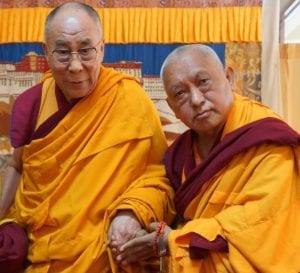
The Meditation Hall at Kopan Monastery in Nepal, where Lama Zopa Rinpoche often teaches
Credit: Aaron Grobler @volcyclart
We all lose loved ones, and may be unsure how to help them through the dying process. Fortunately for Tibetan Buddhists and others looking to draw from their tradition, there are set practices to help loved ones experience death without fear and secure a positive rebirth.

Lama Zopa Rinpoche with His Holiness
the Dalai Lama
Credit: FPMT
According to Lama Zopa Rinpoche, a Tibetan Buddhist scholar and meditator who co-founded the Foundation for the Preservation of the Mahayana Tradition, understanding how to die is essential. “Helping our loved ones at the time of death is the best service we can offer them, our greatest gift,” Lama Zopa Rinpoche states in a handbook outlining 87 practices that can be employed before, during and after the death process. “Why? Because death is the most important time of life: it’s at death that the next rebirth is determined.”
Tibetan Buddhists believe life circles between birth, death and an intermediate state known as the bardo. By providing the right environment and support at the time of death, they believe they can assist their loved one to die peacefully and with virtuous thoughts. As a result, it is expected that they will be reborn in a higher realm – that of gods, demi-gods or humans – rather than in the lower realms of animals, hungry ghosts or hell beings.

The Wheel of Life outside Kopan’s
main Meditation Hall
Credit: Aaron Grobler @volcyclart
Lama Zopa Rinpoche lays out a multitude of Tibetan Buddhist death practices that include beautifying a dying person’s room and displaying holy objects – which, for non-Buddhists, can be images of Jesus, Shiva or other relevant deities. He recommends meditations, reciting mantras or sutras, invoking the person’s guru, and the practice of phowa (which a Lama, or group of practitioners, can also perform on the person’s behalf). He also advocates assisting the dying person to cultivate love and compassion, and to practice renunciation. Attachment – whether to people, possessions or the human body – is considered a top obstacle to a positive rebirth. As an example, Lama Zopa Rinpoche relates a story from Lama Chöden Rinpoche in which a woman, overly attached to her beautiful body, was reborn as a worm living in its corpse.
Stages of the Tibetan Buddhist Dying Process
Lama Zopa Rinpoche’s handbook breaks the practices down into three phases: the time prior to death, the hours after the breath has stopped, and the period after the mind has left the body (which, it is believed, can occur some time after breathing ceases, and can be gauged by various signs). This final section includes the 49 days after death, which is the longest period that Tibetan Buddhists believe someone can remain in the bardo, and during which it’s still possible to influence their rebirth.
While the same practices are often used at multiple stages, Ven. Robina Courtin, the Australian-born Buddhist nun who edited the book, felt it was important to put the Lama’s teachings around death in chronological order. “This really helps you to know how to use the book,” she said. Newcomers to Tibetan Buddhism may be overwhelmed by the sheer volume and complexity of the practices, but they can take heart in Lama Zopa Rinpoche’s assertion that focusing on just one – the Medicine Buddha practice – will be highly beneficial to both the practitioner and their loved one.
Lama Zopa Rinpoche’s recommendations, currently available under the title “How to Enjoy Death: Preparing to Meet Life’s Final Challenge without Fear,” will appear in an updated paperback version next year, under the title “How to Face Death Without Fear.”

 Tibetan Buddhist Death Practices To Help Loved Ones
Tibetan Buddhist Death Practices To Help Loved Ones


 “In Case You Don’t Live Forever” by Ben Platt
“In Case You Don’t Live Forever” by Ben Platt
 Our Monthly Tip: Make an “In Case of Death” File to Ease Loved One’s Grief
Our Monthly Tip: Make an “In Case of Death” File to Ease Loved One’s Grief
 Passing of Beloved Comedian Births a New Comedy Festival
Passing of Beloved Comedian Births a New Comedy Festival














